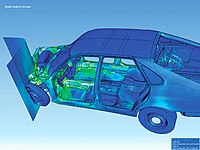
Photo from wikipedia
Abstract In this paper, we have investigated the effect of material orthotropy on the formability of metallic sheets subjected to dynamic biaxial stretching. For that purpose, we have devised an… Click to show full abstract
Abstract In this paper, we have investigated the effect of material orthotropy on the formability of metallic sheets subjected to dynamic biaxial stretching. For that purpose, we have devised an original three-pronged methodology which includes a linear stability analysis, a nonlinear two-zone model and finite element calculations. We have studied 5 different materials whose mechanical behavior is described with an elastic isotropic, plastic anisotropic constitutive model with yielding based on Hill (1948) criterion. The linear stability analysis and the nonlinear two-zone model are extensions of the formulations developed by Zaera et al. (2015) and Jacques (2020), respectively, to consider Hill (1948) plasticity. The finite element calculations are performed with ABAQUS/Explicit (2016) using the unit-cell model developed by Rodriguez-Martinez et al. (2017), which includes a sinusoidal spatial imperfection to favor necking localization. The predictions of the stability analysis and the two-zone model are systematically compared against the finite element results –which are considered as the reference approach to validate the theoretical models– for loading paths ranging from plane strain stretching to equibiaxial stretching, and for different strain rates ranging from 100 s − 1 to 50000 s − 1 . The stability analysis and the two-zone model yield the same overall trends obtained with the finite element simulations for the 5 materials investigated, and for most of the strain rates and loading paths the agreement for the necking strains is also quantitative. Notably, the differences between the finite element results and the two-zone model rarely go beyond 5%. Altogether, the results presented in this work provide new insights into the mechanisms which control dynamic formability of anisotropic metallic sheets.
Journal Title: Journal of The Mechanics and Physics of Solids
Year Published: 2021
Link to full text (if available)
Share on Social Media: Sign Up to like & get
recommendations!